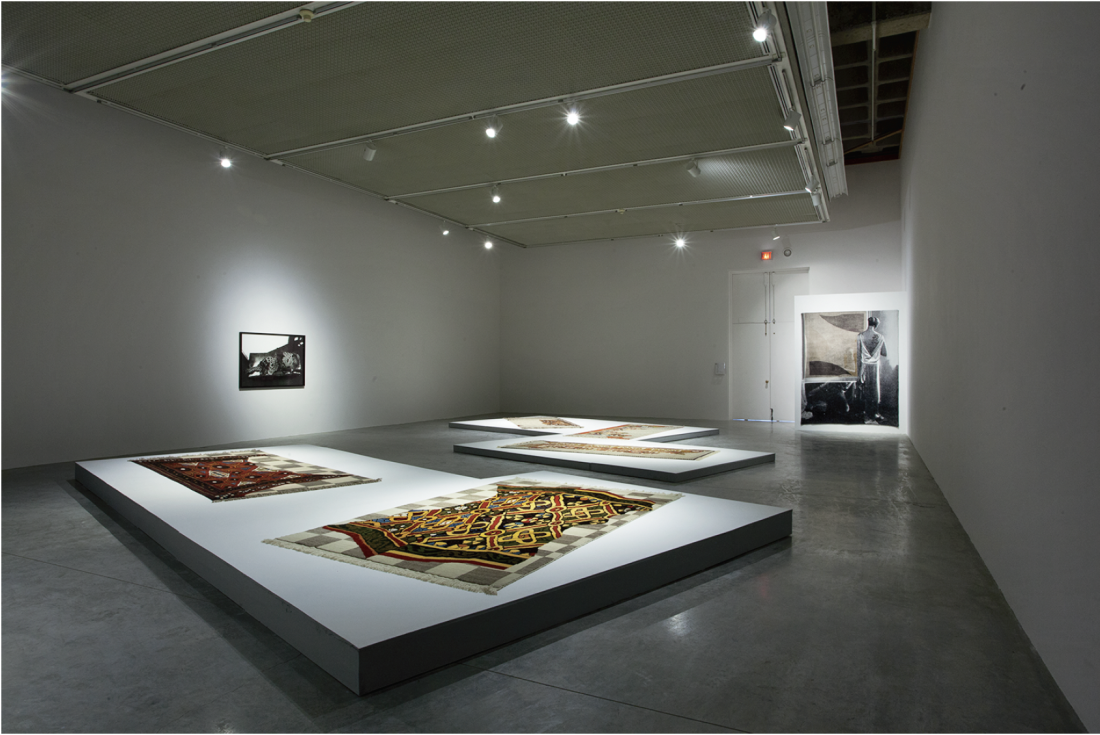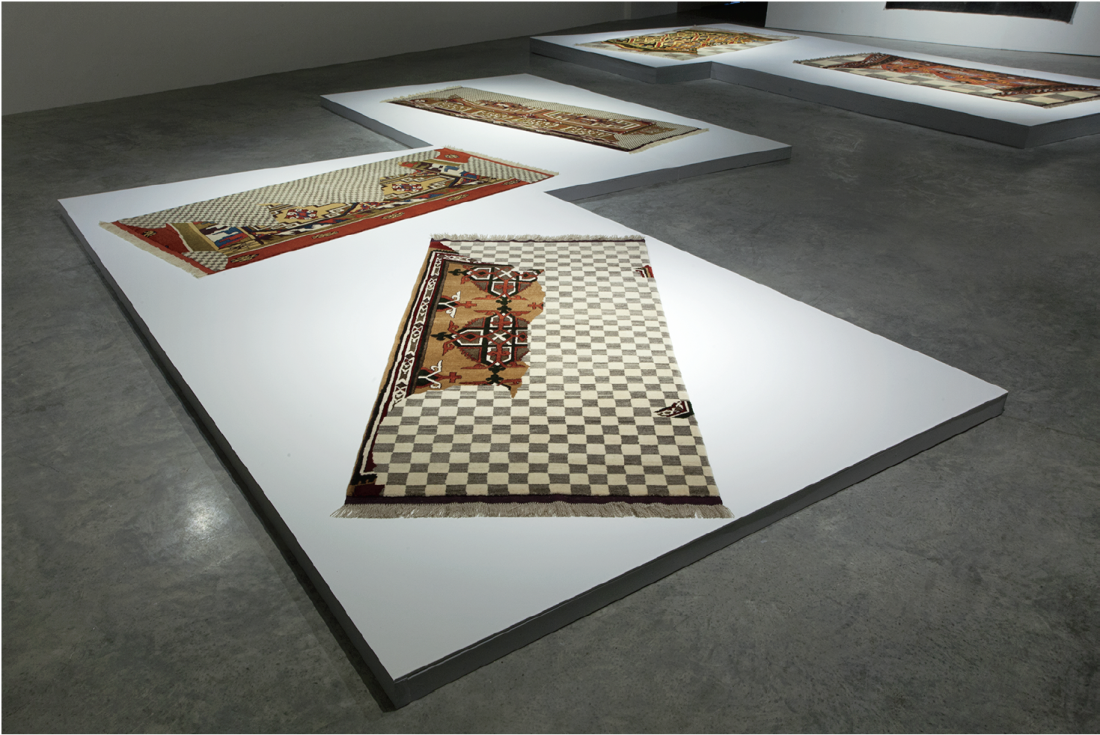Shannon Bool
Shannon Bool’s multidisciplinary practice blurs the lines between art historical disciplines and discourses, particularly decorative and fine art, while implicating psychology, psychoanalysis and pop culture. Born in Comox, BC, Bool received her master’s degree from Frankfurt’s Städelschule (2004), and has subsequently built an impressive international career, based in Berlin. Her solo exhibition, “Shannon Bool: The Eastern Carpet in the Western World Revisited” at the Illingworth Kerr Gallery in Calgary, included five carpets, two tapestries, a photogram and a video. It revisited London’s Hayward Gallery’s “The Eastern Carpet in the Western World: From the 15th to the 17th Century” (1983) to complicate cultural and ideological relationships between Orientalism and art history, as revealed by ornamentation and material culture.

Shannon Bool, installation view, “The Eastern Carpet in the Western World Revisited,” 2017, Illingworth Kerr Gallery, Calgary. Photos: Jeremy Pavka. Courtesy of Illingworth Kerr Gallery.
Earlier works by Bool—Origin/ Inversion, 2005; Broken Pole, 2010; Gaza Zebras, 2012—collaged fragments of modern art and architecture with decorative elements and luscious material processes to reclaim ornamentation from the derisive place assigned to it by modernism. Infamously, Adolf Loos’s Ornament and Crime, 1908, argues ornamentation is superficial, extraneous to both form and function. This racist, classist, sexist, but disturbingly influential text equates ornamentation with immorality, degeneracy, even violence. Bool’s work to date recognizes and exploits Loos’s fear that ornamentation can be a disruptive, even subversive force that reveals and rearticulates power and gender relations far below the surface.
Evocatively installed, the Madonna Extraction Carpets in “The Eastern Carpet in the Western World Revisited” emerged from Bool’s study of Flemish paintings at Frankfurt’s Städel Museum, specifically those intimate Madonna and Child paintings where there is an “Oriental” carpet on the altar in front of the Madonna. In an interview with exhibition curator Lorenzo Fusi, Bool explains these Eastern carpets are “iconographically incongruent with the painting’s content” and mainly unaccounted for within the tradition of Western art history. These “Oriental” carpets stand in for the Other, or that which is disassociated from its cultural content and context by modernism, colonialism and class. Although they are culturally and ideologically unaccounted for, German art historian Erwin Panofsky’s theory of schraegraum describes these ornamental carpets as crucial to the paintings’ distorted perspectival construction, or what Bool has identified as psychological “components of a spatial architecture” that tip the space and lead you into the painting.
Bool began to experiment with these distorting effects of Western perspective on Eastern carpet designs in the wall drawing Origin/ Inversion, 2005, by (mis)aligning in a corner two well-known carpet patterns as represented in Jan van Eyck’s and Hans Memling’s paintings. In 2007 Bool started to make her carpet pictures into actual carpets, engaging ancient workshops in Anatolia, Turkey. One of the first of these, Casino Runner (Aztec Inn), 2011, reappropriated a commercially produced, contemporary design mash-up of Aztec and Anatolian patterns. Bool’s current rectangular carpets picture each carpet excised from the Flemish paintings within a gridded field of grey and white checkers that represent erasure in Photoshop. This digital grid, like the warps and wefts that underlie all weaving, is clearly misaligned with the carpet fragment, highlighting the perspectival distortion present in the paintings. Bool notes how the weavers struggle with the lack of symmetry and repetition in her reappropriated weaving patterns, and must count every knot to remediate the digitally captured painted carpet design back into textile. Furthermore, the off-centre installation of the carpets on intersecting floor plinths accentuates these disorienting perspectival effects because it reorients the vertical plane of the painted carpet representation back onto the horizontal plane of the floor as a material object in real space. In effect, these decorative objects are askew, off-grid, to reveal how contradictory they are to Western modernism’s underlying reductive ideology and the modernist white cube that now contains them.

Shannon Bool, installation view, “The Eastern Carpet in the Western World Revisited,” 2017, Illingworth Kerr Gallery, Calgary. Photos: Jeremy Pavka. Courtesy of Illingworth Kerr Gallery.
Bool’s carpets ask what underlying psychological and ideological structures the surface can reveal. So, too, do her “Analyst” works, one of which is Position #4, a jacquard weaving of a reclining female mannequin based on an image of Charlotte Perriand on a LC4 Chaise Longue (1928) she co-designed for Le Corbusier’s office. The image recalls Freud’s therapist’s couch directly, but also Loos’s gendered (sexist) spatial analysis of the horizontal and vertical axes: “A horizontal line: the reclining woman. A vertical line: the man who penetrates her.” Bool overlays this figure with fragments from a Maori ceremonial doorway to accentuate the sexist and racist ideologies underlying modernism’s appropriation of “primitive” ornamentation and women, particularly Other women’s bodies, for their exotic/erotic signification. The reclining figure’s shadow ominously hovers in the background, projecting a vulnerable image devoid of the specificities of race, gender and class, the ideal modernist subject. Paradoxically, Bool again uses ornamentation here to reveal the erasure of the Other. Ornamentation is Freud’s “return of the repressed,” which reveals underlying ideological tensions in the subject/culture.
Rather than cultural appropriation, Bool reappropriates and remediates the image/object’s social, cultural and often spatial and material histories relative to the ways in which we have come to know them in an attempt to upturn aesthetic and political hierarchies. This is underscored by how she uses digital reproduction in combination with ancient manufacturing techniques to produce contemporary works of art. This process is seen in the carpets, but also in the video, Forensics for a Mamluk, 2013. Bool worked with a photographer to meticulously record the rare 16th-century Turkic-Egyptian Medici Mamluk carpet rediscovered in the Palazzo Pitti in Florence in 1982. Mamluk carpets were often centrepieces in Venetian paintings. Known for their intersecting red, green and blue medallions adapted from Islamic geometric ornament, they induce kaleidoscopic infinity, or the psychedelic effect one might experience in religious, meditative or drug-altered states. Bool’s wallscaled video heightens these effects as she digitally remediates the carpet’s ancient decorative surface using the RGB colour model and disorienting flyover cinematography. Whether it is through the carpets, jacquard tapestries or this video projection, Bool delves deeply into the power of ornamentation to span time and place and to weave less acknowledged threads between Eastern and Western cultural and material histories. ❚
“The Eastern Carpet in the Western World Revisited” was exhibited at Illingworth Kerr Gallery, Calgary, from December 1, 2016, to February 11, 2017.
Diana Sherlock is a Canadian independent curator and writer who teaches critical theory and professional practice in the School of Critical + Creative Studies at the Alberta College of Art + Design.

